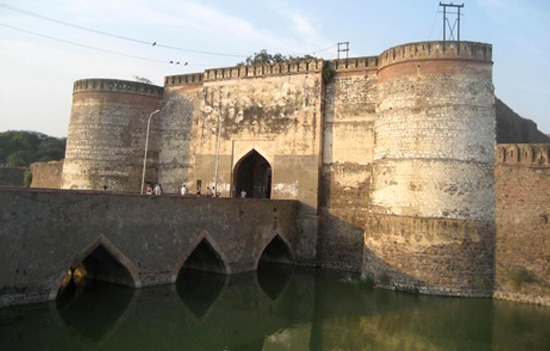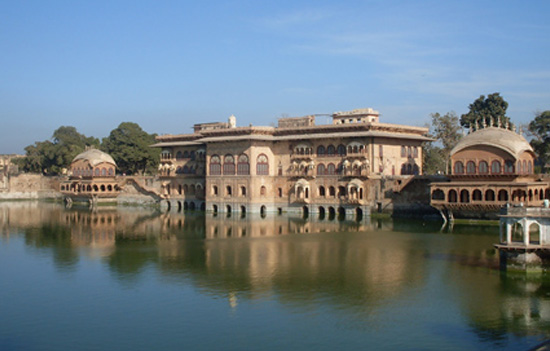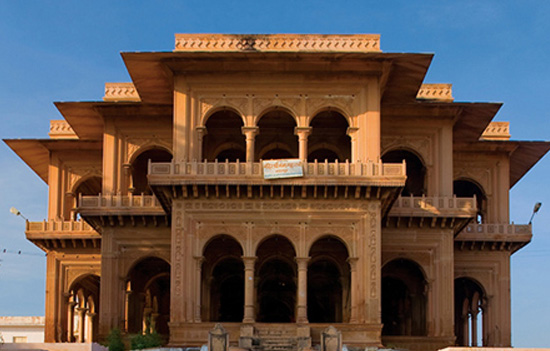- Know about Maharaja Surajmal’s military battles with the Mughals and the Marathas, achievements as a ruler, diplomatic skills and Jat Army.
This
article was written in Hindi by author. Find below an English translation.
The rise of Jats on the political stage of North India during the 18th century was a significant occurrence. In 1669, plagued by Aurangzeb’s oppressive policies, Jat farmers from Brajmandal launched a revolt against the Mughals under the leadership of Gokula. These embryonic efforts eventually culminated in the formation of a powerful Jat kingdom in North India led by Suraj Mal. His father, Thakur Badan Singh, began his life under the patronage of Sawai Jai Singh, the king of Amer (Jaipur).
Not only did Suraj Mal free himself and the Jat kingdom from Amer, but also on 20 October, 1752, he legitimized his rule by obtaining the title of ‘king’ from the Mughal emperor thereby attaining the status of one of the rulers of India. 1
Suraj Mal, also known as Sujan Singh, was the oldest of Thakur Badan Singh’s twenty sons. Rani Devki gave birth to him in 1707. A contemporary French clergyman wrote, “Suraj Mal was above average in height and lean in build. His complexion was a little dark and his face somewhat heavy. His eyes shone unusually bright. His countenance and conduct carried a certain softness and gentleness. Despite his lack of bookish knowledge and courtly etiquette, and an ordinary living and dressing sense, he possessed great political intelligence and perspective.”2 Ghulam Ali, the author of Imad-us-Sadat wrote, “Though he dressed like a farmer and spoke in Brij Bhasha, he was the Plato of the Jats. In intelligence and cleverness, in revenue and administrative matters, with the exception of Nizam Asafjah Bahadur, among the rulers of Hindustan, there was no one who could equal Suraj Mal.”3
He possessed all
the good qualities of his community-energy, courage, tact, hard work and such
an indomitable spirit that defeat was never acceptable. In that age of
conspiracies and immoral diplomacy, he caught the hypocritical Mughals and
clever Marathas off guard.
To sum up, Suraj
Mal was that alert bird which pecked every grain in every trap without ever
getting caught.
Suraj Mal’s first military achievement came in 1732 in the form of a successful campaign led against Khemkara Sogariya, a powerful enemy of his father Badan Singh. The succession struggle in the state of Jaipur presented a new dimension to Suraj Mal’s valour and bravery. In September 1743, with the death of the king, Sawai Jai Singh, his sons Ishwar Singh and Madho Singh began fighting for control of the state. In honour of Jai Singh’s last wish, Suraj Mal remained loyal to the elder son Ishwar Singh while younger son Madho Singh enlisted the military support of his uncle, Udaipur’s Maharana Jagat Singh, and laid a challenge to his brother’s claim. To strengthen his position, Madho Singh bought Malhar Rao Holkar’s support with money.
In this way, along
with Maratha armies, Rathod, Sisodiya, Hada, Kheenchi and Pawar rulers came
together to form a grand army which stood beside Madho Singh. On the other side
was Ishwar Singh with the Jaipur army and Suraj Mal as his only ally. Given
that he was faced with seven kings presenting a united front, things did not
look good for him. But the brave Jats led by Suraj Mal completely turned the
situation around.
On
20th August 1748, in a maidan in Bagaru, both parties began a fierce battle
under pouring rain which lasted for three days. The first two days went badly
for Ishwar Singh. His trusted general Shiv Singh Shekhawat was also killed. But
on the third day, Suraj Mal himself led the attack from the vanguard and laid
to waste the machinations of Malhar Rao Holkar and his general Gangadhar
Tantiya. At this critical time, Suraj Mal displayed great bravery and killed 50
soldiers while injuring another 108.4
Thus, he turned Ishwar Singh’s certain defeat into victory. The unparalleled bravery shown by him on this occasion was
described by Mahakavi Suryamal Misran in the following lines:
सह्यो भलेही जट्टिनी जाय अरिष्ट अरिष्ट।
जाठर तस रविमल्ल हुव आमरेन को इष्ट।।
बहुरि जट्ट मलहार सन लरन लग्यो हरबल्ल।
अंगद है हुल्कर, जाट, मिहिर मल्ल प्रतिमल्ल।। 5
Meaning:
Labour pains borne by the Jat were not in vain, born from her womb, Suraj Mal,
was a curse for his enemies and a benefactor of Amer (Jaipur). Turning away
from the background, the Jat began the battle in Harawal. Holkar, too, stood
steady like Angad; both were equally matched.
These early victories enhanced Suraj Mal’s military prestige and his ambitions grew. Now he turned his attention towards Mewat and Agra by gradually occupying khalisa lands-the land directly owned by the Mughal emperor and the jagirs of Amirs in order to expand the Jat kingdom.
 Lohagarh Fort built by Jat rulers in the 18th century
Lohagarh Fort built by Jat rulers in the 18th century
Due
to his intrusion of royal lands, in January 1749, he had a showdown with
Mirbakshi Salabat Khan of the Mughal Empire. The
royal general was handed a bitter defeat by Suraj Mal and was forced to make a retreat. This success achieved against the Mughal general increased his confidence and prestige. He was ready to play an influential role in the political circle of India’s rulers and to this end, he adopted the political strategy of establishing a friendship with the Wazir of the Mughal Empire, Safdarjung. As a result of their friendship, Suraj Mal now had the patronage of a powerful politician which he could capitalize on to play a greater role in the politics of India, thereby expanding and strengthening his own kingdom.
But
soon, relations between Emperor Ahmad Shah and Safdarjung deteriorated and the Wazir
was removed from his position and also from the governorship of Awadh and
Allahabad. Safdarjung, however, was not ready to accept defeat. With the help
of his friend Suraj Mal, he laid siege to the capital Delhi in order to terrorize
the emperor.
On the other hand, the natural enemies of Safdarjung, the Pathans, led by Najiuddaula, sided with the royal army which was under the new leadership of Mirbakshi Gaziuddin Imad-ul-Mulk. All of Safdarjung’s hopes were pinned on Suraj Mal, who had sacked Old Delhi so mercilessly that people still remember him by the name Jaatgardi.6 Although Safdarjung was slowly
becoming weaker and his allies were deserting him for Imad-ul-Mulk, Suraj Mal
did not abandon his friend in this time of need. He was shown dreams of great veneration
and threatened with retaliation, but neither could sway the loyal Jat Sardar.
He had resolved to fight for his friend until the very end. The Jat king was
not ready to sheath his sword until, if not the post of wazir, then at least
the governorship of Awadh and Allahabad were returned to Safdarjung.
Finally, due to Suraj Mal’s diplomatic efforts, an
accord was reached between the two parties and Safdarjung returned to his
province. In this way, he protected his friend from certain downfall.
 Deeg Palace is inside Deeg Fort, built by Surajmal in 1730.
Deeg Palace is inside Deeg Fort, built by Surajmal in 1730.
Mirbakshi
Imad-ul-Mulk was enraged by the role Suraj Mal played in the civil war between
the emperor and Safdarjung. With the intention of punishing Suraj Mal, he invited the Marathas to attack the Jat kingdom. In
January 1754, under the leadership of Raghunath Rao, several famed Maratha
chieftains and an army of 60,000 laid siege to Kumher, a famous Jat fort. Soon,
Imad-ul-mulk also joined the siege bringing the royal artillery and a force
20,000 strong along with him. For four months-until May 1754-a combined force
of 80,000 Mughal and Maratha soldiers continued the siege of Kumher. Despite
their strength and best effort, they were unable to conquer the fort. During
this time, Khanderao, the only son of Maratha general Malharrao Holkar, fell
prey to shelling coming from the fort and lost his life.
Through diplomacy, Suraj Mal split the Maratha camp by bringing Holkar’s rival Jayappa Scindia, a Maratha general, over to his side. Due to this split, Raghunath Rao was forced to resolve the situation by lifting the siege of Kumher fort.7 This proved to be a great diplomatic
and military win for Suraj Mal which forced the
Marathas to retreat from the Jat kingdom. This event furthered his fame
and his talent came to be acknowledged across northern India.
For
the next two and a half years after the failed Maratha expedition, Suraj Mal
focused on territorial expansion of his state and on improving its internal
systems. He did not have to face any serious problems in this endeavour. But
soon, a crisis would brew which threatened to take over all of North India. In
January 1757, Ahmad Shah Abdali, the famed Afghan emperor, marched into Delhi
with his powerful army. After brutally sacking the capital, plundering it and
massacring citizens, Abdali turned his attention to the Jat kingdom as it was
said that not only was Suraj Mal immensely wealthy but also that most well-to-do
people from Delhi had taken refuge there along with their wealth.
At a time when the Mughal emperor himself, along with all North Indian powers, were forced to bend the knee before Abdali, and with the Marathas too having left Delhi helpless, Suraj Mal’s position was precarious. In February 1757, Abdali sent his commander Jahan Khan and a powerful army to sack the Jat kingdom and massacre its people. Along with 20,000 Afghan soldiers, he also attacked the holy city of Mathura. Suraj Mal’s son Jawahar Singh and 5000 brave Jat warriors fought to defend this holy city. 3000 of them were martyred in this cause. After capturing Mathura, the invading army unleashed a bloody massacre on its residents. In Gokul, Vrindavan and Agra all limits of barbarity were crossed by the Afghans and even more bloodshed, looting and massacres followed. In the meantime, Abdali’s forces were beset by an epidemic and he was forced to turn back home. By the end of March, the Jat kingdom was free of enemies.8
Thus, from a military perspective Abdali’s campaign against Suraj Mal was unsuccessful. He failed to capture the capital Deeg or even Bharatpur, nor could he subdue the proud ruler of this land. He failed to lure Suraj Mal out of his forts and force a confrontation. Suraj Mal’s tactic was to wait until the blistering heat of the Indian summer compelled Abdali’s forces to retreat from his lands. He then held Abdali at bay by
luring him with a promise of paying him ten lakh rupees, but finally, not even
one rupee had to be paid.
In 1761, the Third Battle of Panipat was fought between the Marathas and Ahmad Shah Abdali. Suraj Mal’s support was crucial and both sides did their best to lure him into extending his support. Maratha commander Sadashiv Bhau wrote a letter himself requesting Suraj Mal’s help. Even though the Marathas, like the Rajputs, had done no less harm to the Jats, in the interest of the nation, Suraj Mal thought it prudent to support the Marathas against the heretical and foreign invaders. He took 8000 soldiers and joined the Marathas.
However, differences arose between the two with regards to strategy and planning. With the added disrespect of Bhau’s arrogant behaviour, Suraj Mal felt insulted enough to leave the Marathas and march his army back home.9 The Marathas paid a heavy price in this battle and were almost
vanquished. The ones who survived ran south to the Jat kingdom for refuge.
Dutiful
in his part as a host, not only did Suraj Mal protect them but also lavishly
spent lakhs of rupees on them by providing medicine, clothes and food. If he
would not have put aside the disrespect meted out to him by the Marathas and
not extended his friendship and assistance, very few of them would have been
able to cross the Narmada and relate their sad tale to the Peshwa. Contemporary Muslim and Maratha writers have freely
praised this generosity of Suraj Mal.
Though
the Battle of Panipat proved disastrous for the Marathas, it opened up a new
avenue of opportunities for Suraj Mal. Free from the Marathas and Abdali, he
now had the opportunity to fulfil his ambitions. Just a few months later, he
extended the boundaries of the Jat state by incorporating territories from
Haryana and Doab. Now his next goal was establishing control over the imperial
capital of Delhi.
His
greatest obstacle in this pursuit was Rohilla Sardar Najibuddaula who was
appointed guardian of Delhi by Abdali. Soon a struggle broke out between the
two. Unfortunately, in a sudden ambush by the
enemy, Suraj Mal died on 25th December 1763 at the age of 57. India’s most formidable leader of the past 15 years left the political stage suddenly and with his work unfinished.
 Ganga Mandir was built in 1845 by Maharaja Balwant Singh.
Ganga Mandir was built in 1845 by Maharaja Balwant Singh.
Surajmal’s Achievements
The small kingdom he had inherited had been transformed by him into a powerful kingdom spread across 200 miles east to west and 140 miles north to south. The Jat kingdom was at the pinnacle of glory under Suraj Mal’s rule. Besides the original kingdom of Bharatpur, at the time of his death, the Jat kingdom extended to Agra, Mathura, Etah, Mainpuri, Meerut, Aligarh, entire Mewat (present day Alwar), Rewari, Gurgaon, Rohtak, Jhajjar, Bahadurgarh, Farrukhnagar, Ballabgarh, (present day Haryana), Hathras, Mursan, Jalesar and the adjoining areas of Delhi.
Not
only did he contribute to the territorial expansion of the state but also improved its economic condition as a result of
which his kingdom became one of the most wealthy and prosperous states in North
India. According to Father Vandel, 10 during Suraj Mal’s rule the annual income of the Jat state was one crore and seventy-five lakh rupees and the treasury contained at least ten crore rupees. Along with this, there was also considerable treasure kept underground.
Jat Army under
Surajmal
Numerically speaking his army was not as big but given their fighting skills, capability and organization, it was one of the best armies in India at the time. The Jat army distinguished themselves from other contemporary Indian armies by their qualitative superiority. The author of Siyar-ul-Mutakhkherin, Sayyid Ghulam Hussain Khan, wrote about the cavalry that, “In Suraj Mal’s stables, there are 12,000 horses which run like the wind and mounted on them are as many specially trained gun-toting soldiers. He himself taught them to shoot while on horseback, to do security rounds and to refill gunpowder in cartridges. Because of continued practice, these men had become such swift and sharp shooters, and they excelled in their work so much, that there were no other soldiers in all of India who could pretend to be their equals. Nor was it considered wise to wage a war against such a king for financial benefit.”11
Laziness and indolence were absent in Suraj Mal’s personal life. In matters of military organisation and discipline, he worked rigorously and efficiently. He himself used to train with seasoned cavalrymen and instructed soldiers to be disciplined. In the words of Sayyid Ghulam Hussain, “His army was disciplined and organised. Within him was an innate courageous ability to protect his army, landlords and subjects from enemies. Whenever the royal wazir or Mir Bakshi, Maratha or Durrani attacked him with their large armies, he retreated to secure forts along with the army, generals and subjects in order to delay a military confrontation. He did his best to protect his subjects and kingdom
from invaders. Not once did he give in to military pressure from the enemy and
pay them off. He had a soldier’s fortitude. He also fought the Rohilla Pathans with Wazir Safdarjung by his side. The enemies were fought one by one, and at times in groups, but on each battlefield, they were squarely defeated and Suraj Mal declared victor.”12
To read article in Hindi
References
1. Jadunath Sarkar, Decline of the Mughal
Empire, Volume II, Agra, 1972, p. 270-71
2. Documents of Vandel, 'Jat-Kingdom in India', New Delhi, 2013, p. 164
3. Mir Ghulam Ali, Imad-us-Sadat, Lucknow, 1897, p. 55
4. Kalika Ranjan Qanungo, History of Jats,
Delhi, 2006, p. 41
5. Suryamal Misran, Vansh Bhaskar, p. 3518
6. Girish Chandra Dwivedi, Jat and the Mughal
Empire, Delhi, 2002, p. 168
7. Qanungo, p. 58
8. Natwar Singh, Maharaja Suraj Mal, Delhi, 2006, p. 106-07
9. Qanungo, p. 80-81
10. Vandel, p. 166
11. Sayyid Ghulam Hussain Khan, Siyar-ul-Mutakhkherin,
Volume IV, Calcutta, 1926, p. 28
12. As above
Author Dr. Pramod
Kumar is Assistant Professor, Department of History, MSJ Government College, Bharatpur.